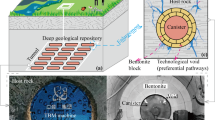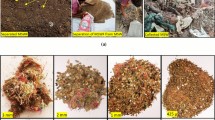Abstract
The organic carbon in shale has been proved to be a significant hydrocarbon source in two occurrences of discrete OM and organic-clay composites. Although the evolution of OM-hosted pores has been investigated by extensive research, the evolution of nanopores in discrete OM and organic-clay composites under additional stress is still unclear. In this study, two potential shales in China (Silurian Longmaxi (S1l) formation and Cambrian Niutitang (Є1n) formation) were selected to examine the nanopores characteristics developed in discrete OM and organic-clay composites using field emission scanning electron microscopy (FE-SEM) and statistical analyses. The microstructure observations of the two shales show that during the growth of nanopores, the expansion of nanopores in composites was restricted by the narrow space between clay layers, and then, the nanopores would be protected from collapse or compaction by clay layers with further maturity. The discrete OM particles constantly suffer squeezing from brittle minerals and lead to the nanopores thrown into compressive environment, resulting in a preferred orientation along the edge of mineral particles and narrowing shape, as well as diminishing the pore sizes. For organic-clay composites, the development of nanopores is determined by additional stress state. Under compressive stress, no pores could be observed, while the nanopores are widely distributed in tensile environment or stress-free state. Consequently, the nanopores development in discrete OM and organic-clay composites are significantly affected by additional stress. The research findings imply the potential hydrocarbon source in the nanopores located in organic-clay composites and would bring inspiration for the exploitation of shale gas.












Similar content being viewed by others
References
Alcover JF, Qi Y, Al-Mukhtar M et al (2000) Hydromechanical effects: (I) on the Na-smectite microtexture. Clay Miner 35(3):525–536
Berthonneau J, Grauby O, Abuhaikal M, Pellenq RJM, Ulm FJ, van Damme H (2016) Evolution of organo-clay composites with respect to thermal maturity in type II organic-rich source rocks. Geochim Cosmochim Acta 195:68–83
Bu H, Yuan P, Liu H, Liu D, Liu J, He H, Zhou J, Song H, Li Z (2017) Effects of complexation between organic matter (OM) and clay mineral on OM pyrolysis. Geochim Cosmochim Acta 212:1–15
Cai J, Song M, Lu L et al (2013) Organo-clay complexes in source rocks—a natural material for hydrocarbon generation. Mar Geol Quat Geol 33(3):123–131
Chalmers GR, Bustin RM, Power IM (2012) Characterization of gas shale pore systems by porosimetry, pycnometry, surface area, and field emission scanning electron microscopy/transmission electron microscopy image analyses: Examples from the Barnett, Woodford, Haynesville, Marcellus, and Doig units. AAPG Bull 96(6):1099–1119
Chen J, Xiao XM (2014) Evolution of nanoporosity in organic-rich shales during thermal maturation. Fuel 129:173–181
Chen GJ, Yen MC, Wang JM, Lin JJ, Chiu HC (2008) Layered inorganic/enzyme nanohybrids with selectivity and structural stability upon interacting with biomolecules. Bioconjug Chem 19(1):138–144
Chen SB, Zuo ZX, Zhu YM et al (2015) Applicability of the testing method for the maturity of organic matter in shale gas reservoirs. Nat Gas Geosci 26(3):564–574
Curtis ME, Cardott BJ, Sondergeld CH, Rai CS (2012a) Development of organic porosity in the Woodford Shale with increasing thermal maturity. Int J Coal Geol 103:26–31
Curtis ME, Sondergeld CH, Ambrose RJ, Rai CS (2012b) Microstructural investigation of gas shales in two and three dimensions using nanometer-scale resolution imaging. AAPG Bull 96(4):665–677
Day-Stirrat RJ, Loucks RG, Milliken KL et al (2008) Phyllosilicate orientation demonstrates early timing of compactional stabilization in calcite-cemented concretions in the Barnett Shale (Late Mississippian), Fort Worth Basin, Texas (U.S.A). Sediment Geol 208(1-2):27–35
Devey R, Curtis CD (1989) Mossbauer and chemical investigations of mud rock. Clay Miner 24(1):53–65
Dong DZ, Wang YM, Li XJ et al (2016) Breakthrough and prospect of shale gas exploration and development in China. Nat Gas Ind 36(1):19–32
Gu Y, Wan Q, Qin Z, Luo T, Li S, Fu Y, Yu Z (2017) Nanoscale pore characteristics and influential factors of niutitang formation shale reservoir in Guizhou province. J Nanosci Nanotechnol 17(9):6178–6189
Gu Y, Wan Q, Yu W, Li X, Yu Z (2018) The effects of clay minerals and organic matter on nanoscale pores in Lower Paleozoic shale gas reservoirs, Guizhou, China. Acta Geochim 37(6):791–804
Guo H, Jia W, Peng Pa et al (2014) The composition and its impact on the methane sorption of lacustrine shales from the Upper Triassic Yanchang Formation, Ordos Basin, China. Mar Pet Geol 57:509–520
Guo C, Xu J, Wu K, Wei M, Liu S (2015) Study on gas flow through nano pores of shale gas reservoirs. Fuel 143:107–117
Hu Q, Ewing RP, Dultz S (2012) Low pore connectivity in natural rock. J Contam Hydrol 133:76–83
Jia W, Segal E, Kornemandel D, Lamhot Y, Narkis M, Siegmann A (2002) Polyaniline-DBSA/organophilic clay nanocomposites: synthesis and characterization. Synth Met 128(1):115–120
Kelemen SR, Fang HL (2001) Maturity trends in raman spectra from kerogen and coal. Energy Fuel 15(3):653–658
Kennedy MJ, Wagner T (2011) Clay mineral continental amplifier for marine carbon sequestration in a greenhouse ocean. Proc Natl Acad Sci U S A 108:9776–9781
Kennedy MJ, Pevear DR, Hill RJ (2002) Mineral surface control of organic carbon in black shale. Science 295:657–660
Kennedy MJ, Löhr SC, Fraser SA, Baruch ET (2014) Direct evidence for organic carbon preservation as clay-organic nanocomposites in a Devonian black shale; from deposition to diagenesis. Earth Planet Sci Lett 388:59–70
King HE, Eberle APR, Walters CC et al (2015) Pore architecture and connectivity in gas shale. Energy Fuel 29(3):1375–1390
Lagely G (1989) Principles of flow of kaolin and bentonite dispersions. Appl Clay Sci 4(2):105–123
Li J, Li X, Wu K, Wang X, Shi J, Yang L, Zhang H, Sun Z, Wang R, Feng D (2016) Water sorption and distribution characteristics in clay and shale: effect of surface force. Energy Fuel 30(11):8863–8874
Liu D, Xiao X, Tian H et al (2012) Sample maturation calculated using Raman spectroscopic parameters for solid organics: methodology and geological applications. Chin Sci Bull 58(11):1285–1298
Liu SG, Deng B, Zhong Y et al (2016) Unique geological features of burial and superimposition of the Lower Paleozoic shale gas across the Sichuan Basin and its periphery. Earth Sci Front 23(1):11–28
Liu AQ, Tang DJ, Shi XY et al (2019) Growth mechanisms and environmental implications of carbonate concretions from the ~ 1.4 Ga Xiamaling Formation, North China. J Palaeogeogr 8(3):285–300
Loucks RG, Reed RM, Ruppel SC, Jarvie DM (2009) Morphology, genesis, and distribution of nanometer-scale pores in siliceous mudstones of the Mississippian Barnett Shale. J Sediment Res 79(12):848–861
Lu L, Cai J, Liu W et al (2013) Occurrence and thermostability of absorbed organic matter on clay minerals in mudstones and muddy sediments. Oil Gas Geol 34(1):16–26
Lu Y, Zhang J, Zhang P et al (2015) Gas accumulation conditions of Lower Cambrian Niutitang shale and prediction of potential zones in northwestern Guizhou. Mar Origin Pet Geol 20(2):37–44
Milliken KL, Rudnicki M, Awwiller DN, Zhang T (2013) Organic matter-hosted pore system, Marcellus Formation (Devonian), Pennsylvania. AAPG Bull 97(2):177–200
Nelson PH (2009) Pore-throat sizes in sandstones, tight sandstones, and shales. AAPG Bull 93(3):329–340
O'Brien NR (1971) Fabric of kaolinite and illite floccules. Clay Clay Miner 19(6):353–359
Rahman HM, Kennedy M, Löhr S, Dewhurst DN, Sherwood N, Yang S, Horsfield B (2018) The influence of shale depositional fabric on the kinetics of hydrocarbon generation through control of mineral surface contact area on clay catalysis. Geochim Cosmochim Acta 220:429–448
Ruppert LF, Sakurovs R, Blach TP, He L, Melnichenko YB, Mildner DFR, Alcantar-Lopez L (2013) A USANS/SANS study of the accessibility of pores in the Barnett Shale to methane and water. Energy Fuel 27(2):772–779
Schieber J, Southard JB, Schimmelmann A (2010) Lenticular shale fabrics resulting from intermittent erosion of water-rich muds--interpreting the rock record in the light of recent flume experiments. J Sediment Res 80(1):119–128
Schoenherr J, Littke R, Urai JL, Kukla PA, Rawahi Z (2007) Polyphase thermal evolution in the Infra-Cambrian Ara Group (South Oman Salt Basin) as deduced by maturity of solid reservoir bitumen. Org Geochem 38(8):1293–1318
Sposito G, Skipper NT, Sutton R, Park SH, Soper AK, Greathouse JA (1999) Surface geochemistry of the clay minerals. Proc Natl Acad Sci U S A 96(7):3358–3364
Sun M, Yu B, Hu Q, Yang R, Zhang Y, Li B (2017) Pore connectivity and tracer migration of typical shales in south China. Fuel 203:32–46
Tang X, Zhang J, Jin Z, Xiong J, Lin L, Yu Y, Han S (2015) Experimental investigation of thermal maturation on shale reservoir properties from hydrous pyrolysis of Chang 7 shale, Ordos Basin. Mar Pet Geol 64:165–172
Theng BKG, Churchman GJ, Newman RH (1986) The occurence of interlayer clay-organic complexes in two New Zealand soils. Soil Sci 142(5):262–266
Tuschel D (2013) Raman spectroscopy of oil shale. Spectroscopy 28(3):20–28
Wang G (2020) Deformation of organic matter and its effect on pores in mud rocks. AAPG Bull 103(1):21–36
Wang P, Jiang Z, Chen L, Yin L, Li Z, Zhang C, Tang X, Wang G (2016) Pore structure characterization for the Longmaxi and Niutitang shales in the Upper Yangtze Platform, South China: evidence from focused ion beam He ion microscopy, nano-computerized tomography and gas adsorption analysis. Mar Pet Geol 77:1323–1337
Wu Y, Ji L, He C, Zhang Z, Zhang M, Sun L, Su L, Xia Y (2016) The effects of pressure and hydrocarbon expulsion on hydrocarbon generation during hydrous pyrolysis of type-I kerogen in source rock. J Nat Gas Sci Eng 34:1215–1224
Zhu X, Cai J, Liu W, Lu X (2016) Occurrence of stable and mobile organic matter in the clay-sized fraction of shale: significance for petroleum geology and carbon cycle. Int J Coal Geol 160-161:1–10
Zhu X, Cai J, Wang G, Song M (2018) Role of organo-clay composites in hydrocarbon generation of shale. Int J Coal Geol 192:83–90
Zhu H, Ju Y, Huang C, Chen F, Chen B, Yu K (2020) Microcosmic gas adsorption mechanism on clay-organic nanocomposites in a marine shale. Energy 197:117256
Funding
This work is supported by the National Natural Science Foundation of China (41802143) and the Doctoral Program of Henan University of Engineering (DKJ2018014).
Author information
Authors and Affiliations
Corresponding author
Ethics declarations
Conflict of interest
The author(s) declare that they have no competing interests
Additional information
Responsible Editor: Santanu Banerjee
Rights and permissions
About this article
Cite this article
Gu, Y., Li, X., Wan, Q. et al. The differential evolution of nanopores in discrete OM and organic-clay composites for shale: insights from stress manipulation. Arab J Geosci 14, 554 (2021). https://doi.org/10.1007/s12517-021-06918-6
Received:
Accepted:
Published:
DOI: https://doi.org/10.1007/s12517-021-06918-6




